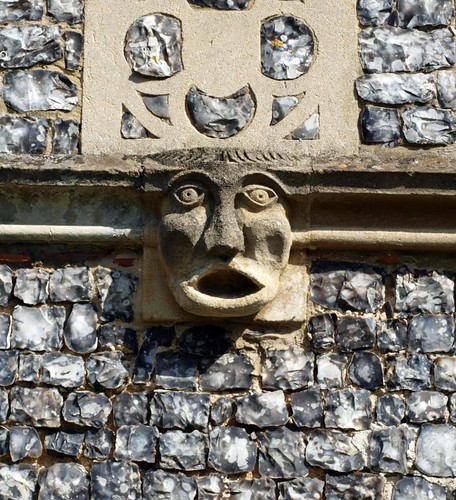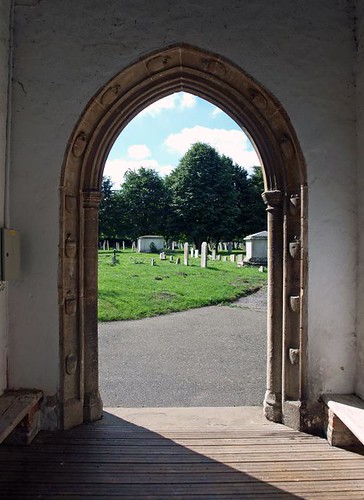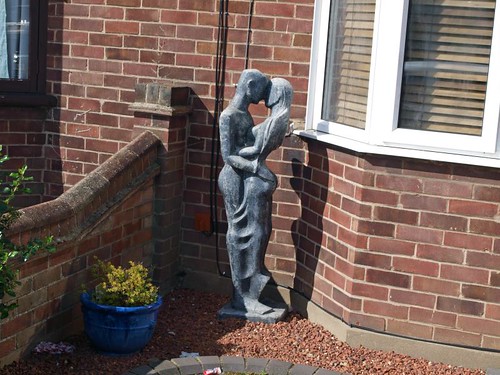All Saints is a surprise: it's an East Anglian style church deep in Essex and is a huge and splendid building which was locked with no keyholder listed although the notice board professed that "this famous XIIIth century church is open only between Easter and Michaelmas on a regular basis". Given that it goes on to announce that the church is only used once a month, except between Easter and Michaelmas when it lays on a service twice a month, regular has a different interpretation around these parts than elsewhere in the county. Which is a pity as it sounds interesting.
St James, on the other hand, is entirely pedestrian - to be fair there was a lot of building work going on, so I didn't see it at its potential best - although the galleries do their best to introduce interest.
ALL SAINTS. A town church, yet away from the little town, higher up and on its own. Like Dedham a grand example of the East Anglian type on Essex soil. Yet there is ample evidence of a building earlier than the years of Perp prosperity. In the S aisle wall W of the doorway a roundheaded recess with Roman brickwork, probably the remaining doorway of an Early Norman church whose nave S wall would have been here. After this follows the chancel. Here, on the N side, one blocked C13 lancet window, on the S side opposite another. The nave S doorway also C13 and simple. Moreover the E parts of the S and N arcades (octagonal piers and double-chamfered arches) belong to the C13 or to c. 1300. Then however the Perp style began its enlarging and remodelling. The W tower was completed in the 1490s. The nave was then lengthened to join it. The S vestry was added c. 1518, the N Chapel c. 1521. The S chapel and S porch seem contemporary. Finally c. 1530 the N aisle was reconstructed. The clerestory fell in 1814 and was not rebuilt - a great pity. The W tower is big and sturdy with a base decorated by shields in quatrefoils. Diagonal buttresses of an unusual section enriched by niches. Four-light W window, two-light window on the second stage, three-light bell-openings with one transome. Battlements pierced and decorated; crocketted pinnacles. S porch with flushwork decoration. Diagonal buttresses with niches. Flushwork base and battlements. Doorway with fleurons and crosses in the voussoirs. One niche above. Three-light side openings. S aisle plastered, with flint battlements. Three-light windows with Perp tracery. S vestry with flushwork decoration in the battlements. N chapel with flushwork decoration in the battlements and base. The N chapel tracery is like that of the S aisle, the N aisle tracery is simpler and later. The arcades inside in the W half of the nave, i.e. the work of c. 1500, have piers of an odd section: lozenge-shaped basically with attached shafts towards the arches (with capitals) a thin polygonal shaft to the nave and recessed parts in the diagonals (all this without capitals). Many niches scattered in the interior: in one of the C13 N piers, in the C13 S window in the chancel, in the E wall of the N chapel. - FONT. Perp, octagonal, with traceried stem and, on the bowl, quatre-foils with roses. Traces of colour found and renewed. - PLATE. Two Cups of 1620, large and scrolly with bands of ornament. - MONUMENTS. Brasses in the N chapel which was the chapel of the Beriffe family. John Beryf d. 1496 and wives. Husband, one wife, some children. - John Beriffe d. 1521, wives and children. Also a merchant’s mark on the plate. - William Beryff d. 1525 and wife. - Alice Beriffe d. 1536 and daughter. Below the figures part of an early C15 architectural surround. - William Beriff of Jacobes d. 1578. Also, in the N aisle: Margaret B. d. 1505 and Mary B. d. 1505 with children. - In the chancel sumptuous monument to Nicholas Magens. By N. Read; erected 1779 (R. Gunnis). The centre is a globe. To the l. of it a winged female figure holding a large scrolled parchment with inscription. To the r. a putto on a gigantic cornucopia. On the r. also a big anchor, on the left relief of ships. Cherubs and cherub heads on top. No effigy.
ST JAMES. In the little town. 1837 by Mason, white brick, in the lancet style, but with none of the personal features that sometimes occur in that architect’s work.
BRIGHTLINGSEA. Almost entirely surrounded by the estuary of the Colne and its tributary creeks, it is a member of the Cinque Port of Sandwich, and its main business is still building boats. It is also a centre of the oyster fisheries. Many narrow streets lead down to the quay from the broad street in which stand the modern church, an old timbered inn, and some quaint cottages. At high tide the quay is a lovely scene with trim yachts and sturdy smacks stretched seaward. In the High Street is Jacobes Hall, one of our oldest timbered buildings, the two steep-roofed wings of its banqueting hall with overhanging storeys.
The Beriffe family of shipping merchants bought the house from the Jacobes about 1400, and probably inserted the great beam across a fireplace in the hall, and the ceiling with its carved oak beams. In the angle between the west wing and the central block is a brick stair turret with a pyramid cap.
The old church stands on the hilltop a mile and a half inland, its 100-foot tower forming a landmark for miles by land and sea. A noble building, the church stands among tall pines, and speaks to us from its walls of the wealthy merchants and the humble seamen who dwelt in the town below for centuries and were borne here for burial. There are brasses of the days before Elizabeth, and for 60 years a tablet has been added to the walls for every sailor from this place who has perished at sea. There are now over 200 of them.
The earliest brass is of 1496, and shows John Beriffe in a long gown with belt and pouch, one of his three wives, and five sons and four daughters. On the floor close by are brasses of over half a dozen members of this family of merchants buried in the 16th century. Dame Alice, who died in 1536, stands with her daughter Margaret on a shaft and bracket of 1420, an old brass used again. John Beryff, mariner, in 1521, bequeathed “to the high altar for my tithes forgotten XXs, towards lengthening of the lady chapel III-quarters of the ship called Trinitie, if God send her well home.”
In the chancel is a huge marble monument erected over the grave of Nicholas Magens, who died in 1767. It cost £6000 and shows a great globe of the world, a laden ship, and a cupid seated on a Cornucopia, with an angel above.
There are many niches in these walls, some still with colour, but only one with its statue. Up the corner buttresses of the tower are 32 beautifully moulded niches, meant probably for sheltering saints, though the saints may never have been in them, for this lovely flint church was only finished just before the Reformation. There is an old sanctus bell and another bell of 1400, a coffin lid with a cross and traces of colour and gilding, a fragment of a Norman arch, old doors, old glass, and many architectural details of delicate craftsmanship.
The Beriffe family of shipping merchants bought the house from the Jacobes about 1400, and probably inserted the great beam across a fireplace in the hall, and the ceiling with its carved oak beams. In the angle between the west wing and the central block is a brick stair turret with a pyramid cap.
The old church stands on the hilltop a mile and a half inland, its 100-foot tower forming a landmark for miles by land and sea. A noble building, the church stands among tall pines, and speaks to us from its walls of the wealthy merchants and the humble seamen who dwelt in the town below for centuries and were borne here for burial. There are brasses of the days before Elizabeth, and for 60 years a tablet has been added to the walls for every sailor from this place who has perished at sea. There are now over 200 of them.
The earliest brass is of 1496, and shows John Beriffe in a long gown with belt and pouch, one of his three wives, and five sons and four daughters. On the floor close by are brasses of over half a dozen members of this family of merchants buried in the 16th century. Dame Alice, who died in 1536, stands with her daughter Margaret on a shaft and bracket of 1420, an old brass used again. John Beryff, mariner, in 1521, bequeathed “to the high altar for my tithes forgotten XXs, towards lengthening of the lady chapel III-quarters of the ship called Trinitie, if God send her well home.”
In the chancel is a huge marble monument erected over the grave of Nicholas Magens, who died in 1767. It cost £6000 and shows a great globe of the world, a laden ship, and a cupid seated on a Cornucopia, with an angel above.
There are many niches in these walls, some still with colour, but only one with its statue. Up the corner buttresses of the tower are 32 beautifully moulded niches, meant probably for sheltering saints, though the saints may never have been in them, for this lovely flint church was only finished just before the Reformation. There is an old sanctus bell and another bell of 1400, a coffin lid with a cross and traces of colour and gilding, a fragment of a Norman arch, old doors, old glass, and many architectural details of delicate craftsmanship.



No comments:
Post a Comment